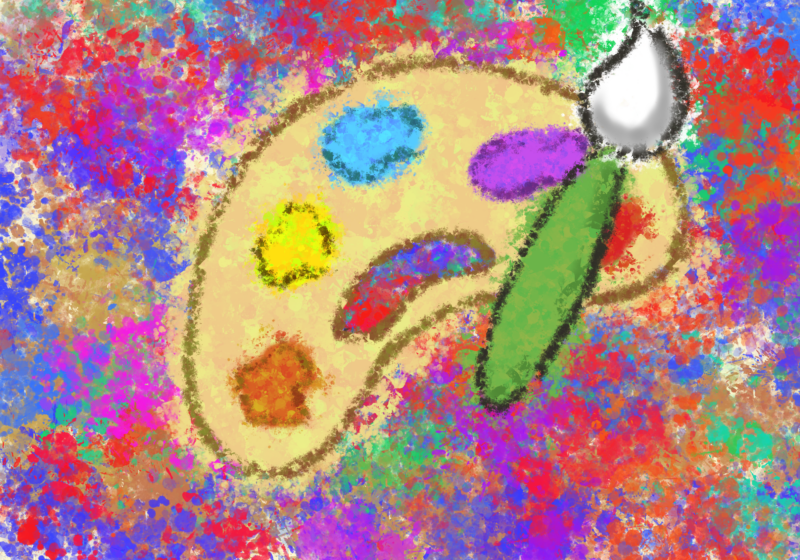Nearly 10 million females and 1 million males in the United States are afflicted by an eating disorder such as anorexia or bulimia nervosa, according to the National Eating Disorder Association. Photographer and installation artist Joy Christiansen examines the issues of eating disorders through the exhibit “Family Gathering: A Look into the World of Eating Disorders,” which is currently on display in the Hartnett Gallery until April 4. She approached this difficult subject through one of the most unsuspecting mediums: furniture – a commonplace in everyone’s home.
“I wanted this installation to look like a typical upper-middle-class living room in the United States,” Christiansen said at her reception. The exhibition is like touring her personal living room, but with a very serious twist that is close to home for her.
Christiansen has had her own experience with an eating disorder in the past and drew on her familiarity and understanding of the topic to aid in the creation of the work.
She chose furniture because “furniture is approachable, people feel more comfortable with furniture, they are more likely to go up and take a look, and the subject is pretty difficult and [one] a lot of people don’t like to talk about,” she said. “Furniture is in the home, eating disorders are in the home, and they are often not talked about with family members, and it is almost like this is kind of the dust and the words that surround or are thick in the atmosphere, and they aren’t actually spoken about.”
Images and text have been applied to each of the different pieces of furniture. The pieces that make up the exhibit include a number of household objects that we interact with on a daily basis.
One of the first things you notice in the gallery are the writings on the walls, a portion of which reads, “There were no distinct signs that led me to believe she suffered from anorexia, it was simply obvious.” In the room, there are lamps with words on the shades that become illuminated when turned on and reveal the ghostly words present. A china cabinet rests against the left wall of the gallery and is filled with pieces of dishware that depict portraits of people and their stories about fighting eating disorders and their symptoms. A desk whose drawers are covered with writings sits against the wall.
“The desk [is] a metaphor for the mind and it [is] where we contain our thoughts, the inner dialogue that happens,” Christiansen said.
Picture frames and portraits of a family affected by eating disorders adorn the wall with their reactions. Christiansen has created an antique bookcase entitled “Bare,” with books made by her and hand-etched windows. The bold words on the piece read, “I felt like a weakness that was being exposed to the world,” with different words on each panel and additional, smaller words as part of the message.
“Hush,” the sofa in the room, has pictures of women in different poses and text as part of the upholstery. There are also two chairs in the center of the room called “Dialogue” that are about a conversation that could take place in the mind, with one chair being the positive side and the other being the negative.
One of Christiansen’s goals was to provide a different point of view than we already have on these disorders.
“I really tried to highlight each piece of furniture as a different perspective of the disorder,” Christiansen said. “The exhibit has been made to be interactive and people are encouraged to pick up the dishes, open the books, open the drawers and engage with the subject through the artistic medium.”
All the writings that are part of the project originate from written interviews that Christiansen conducted through mail and e-mail.
“All of the text came from individuals that I interviewed,” she said. “I interviewed people who had eating disorders and their family and friends and loved ones.” She felt people would be more honest writing about their stories and that, in most cases, they have never said these particular words out loud.
Christiansen expressed that a place like UR is a fitting venue for “Family Gathering.”
“I think the university setting is a really important place to show the work because eating disorders are so prevalent on a college campus,” she said.
The most compelling part of the exhibition is the “Share your story?” wall where people are encouraged to anonymously comment about their own struggles with eating disorders or body image on a piece of paper that can be added to the wall or placed in a box. Many of these accounts and notes may be used in future pieces by Christiansen to further explore eating disorders. Standing and reading people’s accounts of their own experiences with body image and eating disorders has a profound effect on the viewer. It allows you to connect with the author of those words on a personal basis. It is frightening when you stop and think that these could be the thoughts and experiences of fellow students right here at UR.
Levy is a member of the class of 2008.





